How Do We Feed Babies That Are 12-13 Months
11, 12, and 13 months plus can be a difficult time to determine a feeding schedule with so many transitions from baby food and bottles. Get these sample feeding schedules for 1 year olds from a feeding expert and mom.
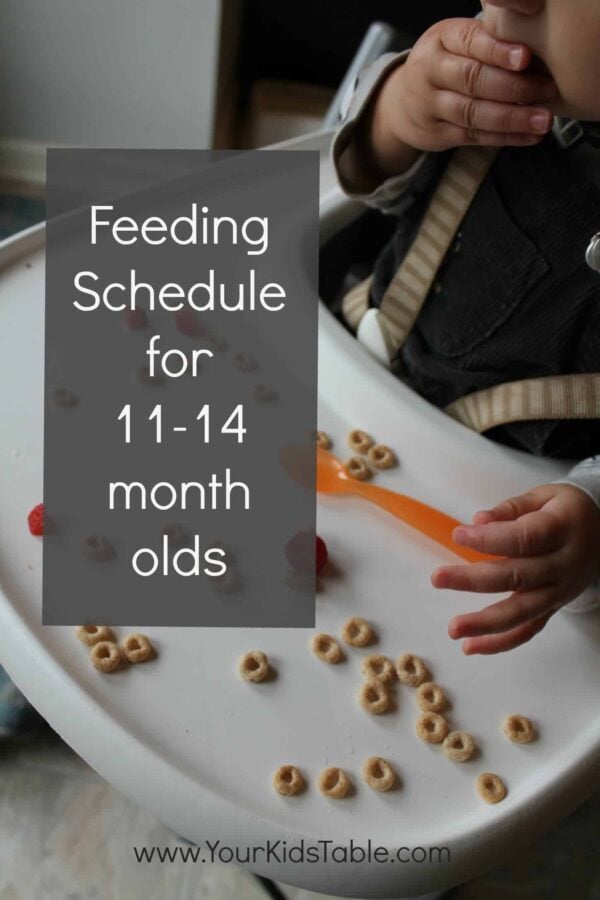
This post is sponsored by Litecup USA.
A baby's first year is filled with many changes, and as it comes to a close around 11 to 12 months, often one of the biggest changes is fully transitioning to table foods and totally leaving behind baby food. At the same time, parents are also trying to navigate how to wean from breast or bottle. Many parents feel overwhelmed and are unsure how to make these changes, and understandably so.
Although I cover transitioning to table food and bottle weaning here in lots of detail, it is important to have a feeding schedule in mind too because it helps make these big transitions successful. Today, I'm sharing three sample schedules with you that I use as a licensed occupational therapist for babies 11, 12, and 13 months old. Basically, a feeding schedule for 1 year olds, so you can see how to make the transitions work for you.
It is fitting that the sponsor of this post is Litecup USA, a no-spill open cup that also lights up! I know, I'm blowing your mind. Think how perfect that will be when you're in the car in the evening or to have on the nightstand for a quick sip if they need it in the middle of the night! It is genius! And, it's fun! Kids, including mine, love it. You will find more in the post about when and why an open cup is great for toddlers.
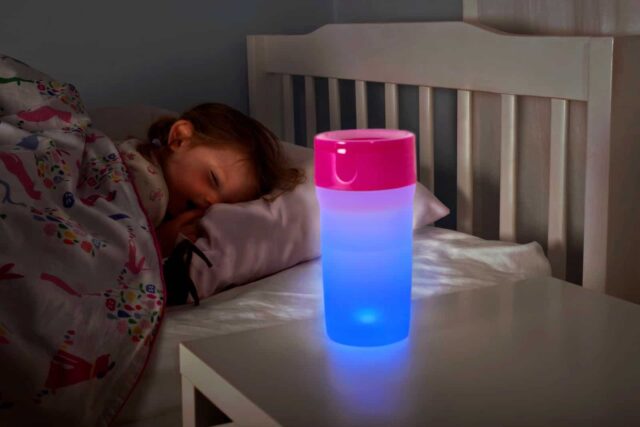
Feeding at 11, 12, and 13 Months (Aka The 1 Year Old!)
If I had to pick one word to summarize feeding babies at this age, it would be: unpredictable. Honestly, they are so busy and easily distracted that at some meals hardly anything is eaten and others they may seem to eat more than you. This is normal, and I want you to keep that mind. It is important to not jump through too many hoops to get your child to eat, because they will soon learn how to wield that power. Setting up a routine and schedule around meals goes a long way in curbing the unpredictability and potential picky eating.
I would also encourage you to move completely to table foods by 11 months, if you haven't done so already. An occasional pouch is okay when you are out and about, but by this age babies should be eating a variety of table foods. The schedules I share below are made based on this assumption. See further down in the post if your child is having difficulty with this transition.,
In my 8-10 month old feeding schedule, I recommended introducing a straw. If you haven't done that yet, no problem, they will likely pick it up very quickly. While the straw is a great choice, at this age, your child may be ready to drink from an open cup. I know how shocking that sounds. It is a surprise to most parents, but stay with me.
Open cup drinking is an important developmental skill, and challenges children to use the muscles in and around their mouth in new and different ways. This helps them progress with managing different types of food, as well as their speech. Great, right? But, what about the mess? It is true that there will be a lot of spills and wet shirts with traditional open cups, or you can use a Litecup that has all the benefits of drinking from an open cup without any of the mess! Win- win! I love it, it is the best of both worlds. So be brave and give the open cup a chance. It is a wonderful tool to add into your routine, as you can serve your child's milk and water in it during mealtime.
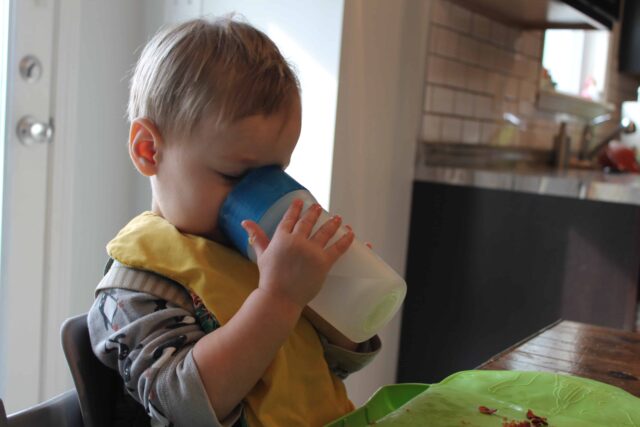
Because this is a time of transition, I'm going to share with you three schedules so that you can see the transitions. First, you will see the schedule at the beginning of 11 months, then you will see it once the baby is weaned, usually around the first birthday or in the next few months. In the latter case, I gave you samples for either one or two naps, as this is often a transition at this age too! Of course, all of these factors vary from child to child.
Get more specifics for bottle weaning and breast weaning.
* Learn 5 Big Mistakes that Parents (Unknowingly) Make When Feeding Their Baby or Toddler Table Foods in my free workshop . And, learn what to do to help them eat well!*
Sample Feeding Schedule Around 11 Months Old
*This schedule is just a sample. Your child may sleep at different times and you will need to adjust accordingly. I suggest taking note of the time intervals so that you can apply to you child's individual schedule. You can use this 1 year old sleep schedule as a reference.
6:30-7:00 AM: Wake-Up – Breastfeed/Bottle upon waking *This is usually the second to last feeding you will take away. Sometimes it's the last if your child is more attached to this than the night time feed.
7:00-7:30 AM: Breakfast – Water available in an open cup or straw cup, table foods (include a fruit/veggie, carbohydrate, and protein).
9:30 AM: Nap
11:00 AM: Breastfeed/Bottle upon waking *This is usually the first milk feeding I take away, if there are no complaints from the baby, and I promptly feed them lunch instead with milk in a cup. Some babies may start to nurse or take very little from a bottle earlier than their birthday. It is okay to follow their lead.
11:30-12:00 PM: Lunch – Water in a straw cup, table foods (include a fruit/veggie, carbohydrate, and protein).* Give milk at this meal once the previous formula/breast milk is eliminated.)
1:30-2:00 PM: Nap
3:30 PM: Breastfeed/Bottle upon waking, immediately followed by an optional small snack such as fruit and crackers/dry cereal/rice cake. *This is typically the second bottle or breast feeding I take away, but it can be the first if this works better. Once this bottle is gone, offer milk in a cup and some protein to the meal like peanut butter, hummus, cheese, or beans.
6:00 PM: Dinner – Water in an open cup or straw cup, table foods (include a fruit/veggie, carbohydrate, and protein).
7:30- PM: Breastfeed/Bottle before bed *Typically this is the last breastfeed or bottle you will take away, and it can be the most difficult. However, feedings at this time won't interfere with their other meals.
7:45-8:00 PM: Sleeping for the night
*Times are given in a range of possible start times, not duration. If you are concerned about how much your baby needs to eat, see this post onPortion Sizes.
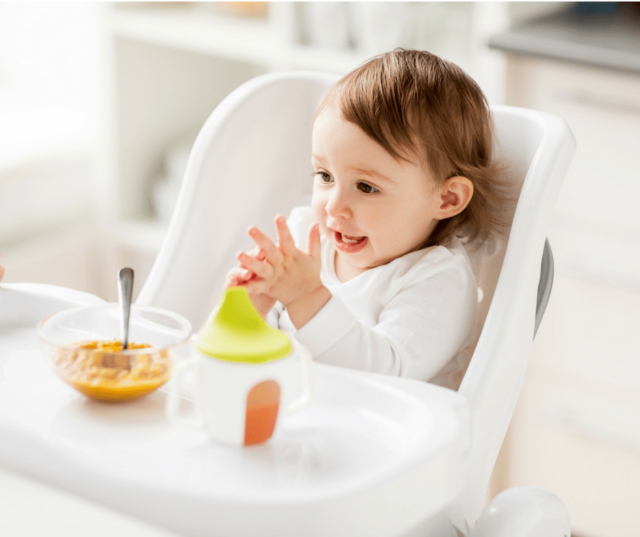
1 Year Old Feeding Schedule (2 Naps)
Specifically, this is an example around 12 – 13 months
7:30 – 8:00 AM: Breakfast – 15-30 minutes after waking. About 4 oz. of milk in an open cup or straw, a protein, carbohydrate, and fruit/veggie.
10:30 AM: Nap
12:00 PM: Lunch – 15-30 minutes after waking. About 4 oz. of milk in an open cup or straw, a protein, carbohydrate, and fruit/veggie.
2:30 PM: Snack – About 4 oz. of milk in an open cup or straw, a protein, carbohydrate, and fruit/veggie.
3:00 PM: Nap
5:30 – 6:00 PM: Dinner – About 4 oz. of milk in an open cup or straw, a protein, carbohydrate, and fruit/veggie.
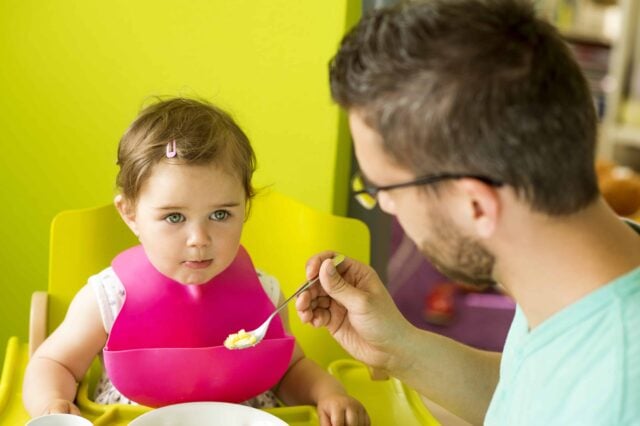
1 Year Old Feeding Schedule (1 Nap)
Beginning around 12-13 months Old
7:30- 8:00 AM: Breakfast – 15-30 minutes after waking. About 4 oz. of milk in an open cup or straw, a protein, carbohydrate, and fruit/veggie.
11:00 AM: Lunch – About 4 oz. of milk in an open cup or straw, a protein, carbohydrate, and fruit/veggie.
12:00 PM: Nap
2:30- 3:00 PM: Snack – 15-30 minutes after waking: About 4 oz. of milk in an open cup or straw, a protein, carbohydrate, and fruit/veggie. *This meal should include all the elements listed, but will be on a little smaller of a scale.
5:30 – 6:00 PM: Dinner – About 4 oz. of milk in an open cup or straw, a protein, carbohydrate, and fruit/veggie.
A Few Feeding Tips
- Milk should be around 16 oz. total for the day after 1 year of age.
- Ideally, meals should be spaced 2.5 – 3 hours apart, counting from the start of one meal to the start of the next.
- Babies and toddlers are capable of feeding themselves a lot of food at this age. Yes, it's messy, read the benefits here. I encourage you to allow them to feed themselves as much as possible, even with a spoon!
- If your baby is gagging a lot or you're nervous about their occasional gag, then head to What You Need to Know About Baby Gagging.
- Try to have as much variety in your toddler's diet as possible, ideally not serving the same thing two days in a row. Need some inspiration? I've got you covered! See The Mega List of Table Foods or The Ultimate List of Meals for Toddlers.
- If you're concerned about how many calories they're eating or need to increase your babies weight, then see High Calorie Foods for Babies.
- Around this time you may also be considering getting rid of the binky or dummy, if so, I've got a guide that will help you know when and how to do it. Check out Everything You Need to Know About Pacifier Weaning.
What If This Eating Thing Isn't Going Well?
If you feel like your baby isn't getting the hang of table foods or is consistently eating very small amounts of food at 10 months of age, then I would strongly suggest scheduling an evaluation through early intervention (if you live in the states) or seeking out a private or outpatient therapist. I also have this free printable: Learn to Eat Table Foods Cheat Sheet, that I'll send right to your inbox. It has a step-by-step plan and some other tips that will be helpful.
Get the Free Printable Here!
Unfortunately, many times, pediatricians advise to wait it out, but trained feeding therapists (usually OTs and SLPs) are able to catch early signs of underlying sensory or motor difficulties. The earlier these problems are addressed, the easier they are to overcome. Head to Everything About Feeding Therapy to read more.
More on Feeding Schedules for Babies from Your Kid's Table
The Best 6 and 7 Month Old Feeding Schedule, So Easy to Follow
Introducing Baby Food: Everything You Need to Know
The Ultimate Guide to Feeding Milestones for Babies and Toddlers
Feeding Red Flags for Babies and Toddlers
Did You Pin This?
You'll want to check this out again! Pin it here or hover/tap on any image to get the pin it button.
Alisha Grogan is a licensed occupational therapist and founder of Your Kid's Table. She has over 14 years experience with expertise in sensory processing and feeding development in babies, toddlers, and children. Alisha also has 3 boys of her own at home. Learn more about her here .
How Do We Feed Babies That Are 12-13 Months
Source: https://yourkidstable.com/toddler-feeding-schedule/
0 Response to "How Do We Feed Babies That Are 12-13 Months"
Post a Comment